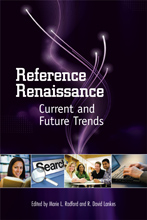The following video talks about the structure of the Atlas and how it works:
By the way, If you are wondering why the video is in portrait and not landscape – it has to do with their use on the iPad app.

Scholar | Speaker | Writer | Teacher | Advocate
The following video talks about the structure of the Atlas and how it works:
By the way, If you are wondering why the video is in portrait and not landscape – it has to do with their use on the iPad app.
The Atlas of New Librarianship will be officially announced (and sold) at this year’s ACRL conference in Philadelphia on March 31st at 2. If you have followed this blog you know what the Atlas is, and have been seeing the creation process of the book, the companion website, and the companion iPad app. To get ready for the launch, I wanted to take the next two weeks to give you a taste of the Atlas and the companion content.
Over the coming days I’ll post video clips introducing the different threads and section of the Atlas. Today I’d like to share the introductory video for the companion site:
I’ve done a quick screencast of the companion website and iPad app I’m working on for the forthcoming Atlas of New Librarianship. Please be kind, it is very much a work in progress:
A sneak peek at the coming web and iPad companions to the Atlas of New Librarianship.

For new readers of my blog, my new book, The Atlas of New Librarianship, is being co-published by MIT Press and ACRL this spring. You can follow the links in this post to more about the content of the book. This post is to give folks an update on where we are in production.
First, we have a cover! If you are reading this post, you are seeing it.
Secondly, we have a date! The book is being launched at the ACRL 2011 (http://www.ala.org/ala/mgrps/divs/acrl/events/national/2011/). It then will be on sell starting in April.
Thirdly, work has started on a series of Atlas companion pieces like a website and iPad app. To keep up and ask questions feel free to follow along at http://newlibrarianship.org. Half of the book will be available full text, plus places to keep evolving and discussing the Atlas and New Librarianship, plus new indexes and video. You can also join us on Facebook at http://www.facebook.com/apps/application.php?id=169908193049267. Both of these spaces are still very much a work in progress, so don’t expect too much life until March.
Lastly, a special shout out to MIT Press and ACRL. This is going to be a beautiful book 10″x10″ full color with a pull out poster/map and only $55 at about 500 pages. Also a special thanks to the literally hundreds of librarians that have been part of the process and ideas in the Atlas.
We’ve also already gotten some nice reviews:
“Deep thinking, beyond brands, down to the core concepts and competencies that define librarianship. Lankes creates thoroughly described verbal and visual explanations of the relationships between the many disparate parts that make up our professional whole.”
—Jessamyn West, community technology librarian, blogger, and creator of librarian.net“The Atlas is not a book; it is a manifesto, a set of principles and convictions aimed at shaking new life and belief into a field that too often fears for its own future. Read it and be prepared to act.”
—Andrew Dillon, Dean and Louis T. Yule Regents Professor of Information, School of Information, University of Texas at Austin
So feel free to follow along and take a look at the MIT Press page for the book.
More soon.
Lankes, R. David (2010). Innovators wanted: No experience necessary? In Walter and Williams (Eds.), The expert library: Sustaining, staffing, and advancing the academic library in the 21st century. Association of College and Research Libraries.
Conversations and the True Knowledge of Generations. Lankes, R. David (2010). In Boomers and beyond: Reconsidering the role of libraries. Rothstein, P. M., and Schull, D. D. (Eds). Chicago: American Library Association.
“Ereaders, the iPad-Is That All There Is?” Lankes, R. David (March 25, 2010). School Library Journal.
 http://www.schoollibraryjournal.com/article/CA6723753.html?desc=topstory
http://www.schoollibraryjournal.com/article/CA6723753.html?desc=topstory
I’ve made a few allusions to my next book in my presentations, and even posted a picture of the draft here. Now that it is official I’d like to be a bit more specific.
The Atlas of New Librarianship will be published in Spring 2011 by MIT Press and is co-published by ACRL. The Atlas is a thorough discussion of librarianship developed around the concept of “participatory librarianship.” The central concepts of participatory librarianship have not changed – that conversation and knowledge are core to all that librarians do. However, while you will read a great deal about participation, you will not see many specific references to “participatory librarianship.” This is intentional.
While modifiers and titles are useful in gaining attention, the ultimate success of any idea is the loss of a modifier. “Virtual reference” becomes simply “reference” when the ideas put forth are widely incorporated throughout practice. “Digital libraries” are quickly becoming simply “libraries” as they become integrated into the larger organizations and collections of a library. So too must participatory librarianship, if it is to be successful, become part of the overall concept of librarianship.
The library field is searching for solid footing in an increasingly fragmented information environment. As technology changes, budgets shrink, and use demographics fluctuate what can help guide librarians to continued relevancy and success? The answer must go beyond Web 2.0, or technological landmarks and provide a fundamental and durable foundation for the field. What is the role of a librarian in a space with no collections – or walls? How do we prepare the next generation of librarians? The Atlas seeks to answer these questions.
The Atlas represents a new understanding of librarianship based on work with organizations such as the American Library Association, OCLC, The U.S. Department of Justice Law Libraries, the Free Library of Philadelphia, and the State Library of Illinois. It is founded on the basic concept that knowledge is created through conversation; libraries being in the knowledge business are therefore in the conversation business. This concept, grounded in theory, leads to a new mission for librarians:
The mission of librarians is to improve society through facilitating knowledge creation in their communities.
This implications, foundations, and application of this mission is discussed and detailed in the Atlas.
Perhaps the easiest way to explain the Atlas is by showing how it can be applied, as I have done in some recent presentations:
Excerpt from Charleston Conference 2009:
Excerpt from Pennsylvania District Library Keynote:
In addition to a full-color 10″x10″ print version of the book, we are creating an online companion site to foster ongoing conversations around the foundations of librarianship. More details on that to come.
A special thanks to all of those instrumental in writing this including Buffy Hamilton, Megan Oakleaf, Scott Nicholson, Jill Hurst-Wahl, Michael Luther, Todd Marshall, Angela Usha Ramnarine-Rieks, Heather Margaret Highfield, Jessica R. O’Toole, and Xiaoou Cheng and so many many more. Also thanks to all my early reviewers who gave me great feedback.
 Just received a package with my author’s copies of Reference Renaissance: Current and Future Trends. The book is built from the papers and presentations at the Reference Renaissance Conference in Denver. It is a really great volume of what is happening in reference and I am thrilled to see the tradition of good research and good practice continuing from the VRD conferences of ‘ole.
Just received a package with my author’s copies of Reference Renaissance: Current and Future Trends. The book is built from the papers and presentations at the Reference Renaissance Conference in Denver. It is a really great volume of what is happening in reference and I am thrilled to see the tradition of good research and good practice continuing from the VRD conferences of ‘ole.
Reference Renaissance: Current and Future Trends. Radford, M., and Lankes, R. David (Eds.). (2010). New York: Neal-Schuman Publishers.